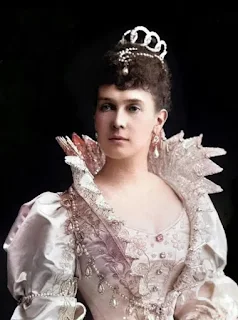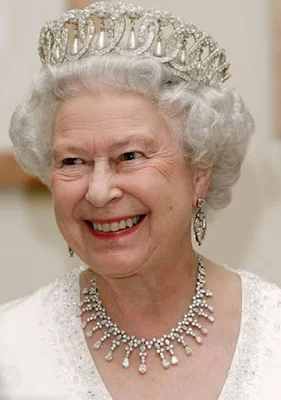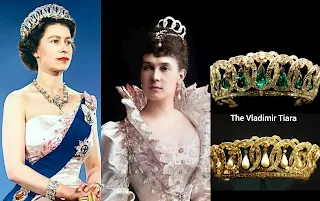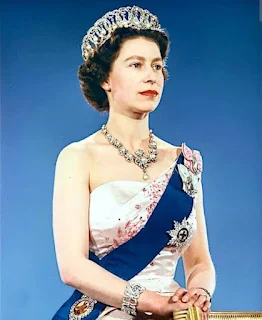The British Royal Family has an extensive collection of royal jewelry, especially head sparklers, and yet, during her long reign, the beloved late Queen Elizabeth II, had at least one favorite tiara she turned to over and over again during important state occasions and official portraits - the Vladimir Tiara.
The story of how this magnificent Romanov topper came into the House of Windsor is as interesting as the story of the collapse of the imperial Romanov in Russia.
| Queen Elizabeth II sat for an official portrait in 1959 wearing the Vladimir Tiara with pearls |
It was originally owned by the great grandmother of the Queen's cousin, Prince Edward, the Duke of Kent - Grand Duchess Maria Pavlovna of Russia. She was born Duchess Marie of Mecklenburg-Schwerin in Germany.
Here's how the story began...
Duchess Marie of Mecklenburg-Schwerin, known by her nickname, Miechen, was the aunt of Queen Juliana of The Netherlands and Queen Alexandrine of Denmark (wife of King Christian X of Denmark). In 1874, she married Grand Duke Vladimir, the third son of Emperor Alexander II of Russia and Princess Marie of Hesse and by Rhine.
 |
| Grand Duchess Maria Pavlovna of Russia wearing the Vladimir Tiara without pendants |
Through her marriage, Miechen became the sister-in-law of Prince Alfred, Duke of Edinburgh and Saxe-Coburg, and Gotha (second son of Queen Victoria), and Princess Dagmar of Denmark (wife of Emperor Alexander III of Russia).
The marriage produced four children including Grand Duke Kyril Vladimirovich (who married Princess Victoria Melita, daughter of Prince Alfred), and Grand Duchess Elena, who married Prince Nicholas of Greece and Denmark, uncle of Prince Philip. They were the parents of Princess Marina who married Prince George, Duke of Kent.
 |
| Grand Duchess Maria Pavlovna of Russia wearing the Vladimir Tiara with pearls |
Miechen became known in Russia as Grand Duchess Maria Pavlovna. She was known as the grandest of all grand duchesses, however, she was also known having a complicated relationship with her sister-in-law, Princess Dagmar, the mother of Nicholas II, who was known in Russia as Empress Marie Feodorovna.
Grand Duchess Maria had a massive collection of jewelry and in order to add glamour to her collection, her husband, Grand Duke Vladimir, commissioned the Court Jeweler, Bolin, to create a magnificent tiara for his wife made from diamonds and pearls.
 |
| Vladimir Tiara with pearls |
This tiara became known as the Bolin Diamond Loop for a while before it became known as Grand Duchess Vladimir Tiara. Made in gold and silver, this Romanov tiara became a symbol of regal and splendor in the Russian imperial court.
The tiara originally consisted of interlocking diamond rings set with old mine cut brilliant diamonds, having undulating diamond ribbon on top which accommodated hanging claw-set pearls.
Grand Duchess Maria Pavlovna wore it in both its original and closed-circlet form—meaning without the backing row of curved diamonds and the pearl drops.
The collapse of the empire
In 1917, when the Emperor Nicholas II was forced to abdicate and his family was taken under house arrest, Grand Duchess Maria hid in the Caucasus with her son, Grand Duke Vladimir, and his family. Her massive jewelry collection remained hidden at their home in Vladimir Palace in St. Petersburg.
Without any hope of freedom to get back to their normal lives in Russia, and with the Bolsheviks began arresting the Imperial Grand Dukes, Grand Duchess Maria asked a family friend, Albert Stopford, a British antique dealer who also served as a British spy in Petrograd, to retrieve her collection of jewelry.
The way Miechen's jewelry collection was taken out of the Vladimir Palace's secret vault by Stopford sounded like a scene in a James Bond film.
Stopford was secretly observing the movements of the revolutionists around Vladimir Palace and studying how to enter the palace without attracting suspicion from the revolutionists.
 |
| Vladimir Tiara with emeralds |
In September 1917, Stopford and one of the sons of Miechen, Grand Duke Boris, disguised as workmen to enter the Vladimir Palace. With the secret help of the palace workers, they were able to retrieve most of the Grand Duchess's jewelry, including the precious Vladimir Tiara.
Miechen and her family were then rescued by the British warship and were brought out of Russia. She first settled in France and died there in 1920.
 |
| Queen Mary wearing the Vladimir Tiara with her emeralds |
Before her death, Miechen sold some of her precious jewelry to support themselves during exile. Some were distributed to her children.
The Vladimir Tiara was inherited by her only daughter, Grand Duchess Elena. She was the mother of Princess Marina, the wife of Prince George, Duke of Kent. She later sold the tiara to Queen Mary, consort of King George V of Britain, and the mother of Prince George.
It was one of the grandest tiaras from the imperial Romanov to be sold. And since it was partly damaged during transit to London from Russia so Queen Mary brought it to the Crown Jeweler, Garrard, to have it repaired. adding her own emeralds to the design.
 |
| The Queen wearing Vladimir Tiara without hanging pendants |
 |
| With emeralds on the loops |
 |
| With Pearls on the loops |
The new design of the Vladimir Tiara allows the wearer to switch emeralds and pearls on the intersecting diamonds. When Queen Mary died, it was inherited, as with all the crown jewels, by her granddaughter, Queen Elizabeth II.
In 1988, Queen Elizabeth II made altercation of the tiara, remaking the frame in platinum.
The Vladimir Tiara became one of the Queen's favorite tiaras, often wearing it during official portraits and important state occasions, due to the crown's regal design and varieties of style. As if she's wearing three different tiaras.
 |
| Vladimir Tiara with pearls |
 |
| Vladimir Tiara with emeralds |
Queen Elizabeth II would wear it in three ways to match her earrings and necklace for the occasion: without pendants, with pearls, or with emeralds. It is through these versatility that the tiara endeared to the late Queen.
During her long reign, the Vladimir Tiara was solely worn by Queen Elizabeth II and was never loaned to other members of the Royal Family, not even to royal brides.
 |
| one of the Queen's favorite tiaras |
Today, the Vladimir Tiara and the rest of the Crown Jewels are now under the custody of King Charles III and his consort, Queen Camilla, can now wear it if she wanted. Looking forward to the day we will see this splendid tiara again make a public appearance.








0 Comments